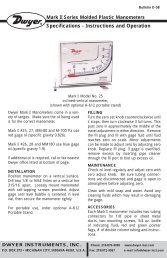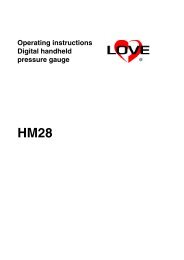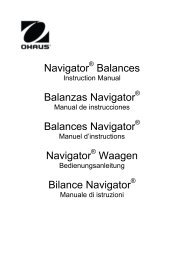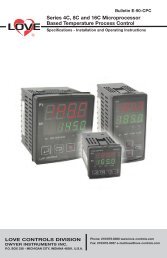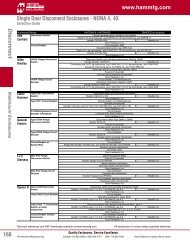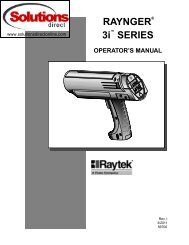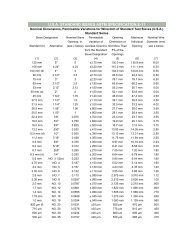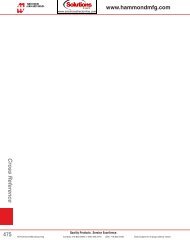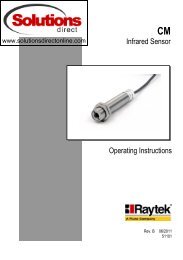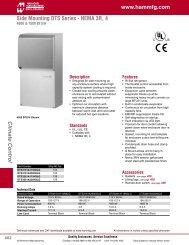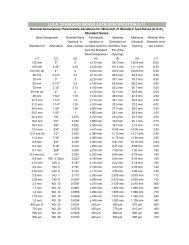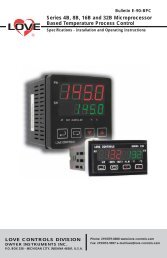Raytek MI Series Noncontact Infrared Temperature ... - Solutions Direct
Raytek MI Series Noncontact Infrared Temperature ... - Solutions Direct
Raytek MI Series Noncontact Infrared Temperature ... - Solutions Direct
You also want an ePaper? Increase the reach of your titles
YUMPU automatically turns print PDFs into web optimized ePapers that Google loves.
<strong>MI</strong>Miniature <strong>Infrared</strong> SensorOperating InstructionsRev. G1 01/201054301
Declaration of Conformity for the European CommunityThis instrument conforms to:EMC: IEC 61326‐1:2006Safety: IEC 61010‐1:2001
Contacts<strong>Raytek</strong> CorporationWorldwide HeadquartersSanta Cruz, CA USATel: +1 800 227 – 8074(USA and Canada only)+1 831 458 – 3900solutions@raytek.comEuropean HeadquartersBerlin, GermanyTel: +49 30 4 78 00 80raytek@raytek.deFranceinfo@raytek.frUnited KingdomTel:+44 1908 630 800ukinfo@raytek.comChina HeadquartersBeijing, ChinaTel: +86 10 6438 691info@raytek.com.cnInternet: http://www.raytek.com/Thank you for purchasing this <strong>Raytek</strong> product. Register today atwww.raytek.com/register to receive the latest updates, enhancementsand software upgrades!© <strong>Raytek</strong> Corporation.<strong>Raytek</strong> and the <strong>Raytek</strong> Logo are registered trademarks of <strong>Raytek</strong> Corporation.All rights reserved. Specifications subject to change without notice.
WARRANTYThe manufacturer warrants this instrument to be free from defects inmaterial and workmanship under normal use and service for theperiod of two years from date of purchase. This warranty extendsonly to the original purchaser. This warranty shall not apply to fuses,batteries, or any product that has been subject to misuse, neglect,accident, or abnormal conditions of operation.In the event of failure of a product covered by this warranty, themanufacturer will repair the instrument when it is returned by thepurchaser, freight prepaid, to an authorized Service Facility withinthe applicable warranty period, provided manufacturer’sexamination discloses to its satisfaction that the product wasdefective. The manufacturer may, at its option, replace the product inlieu of repair. With regard to any covered product returned withinthe applicable warranty period, repairs or replacement will be madewithout charge and with return freight paid by the manufacturer,unless the failure was caused by misuse, neglect, accident, orabnormal conditions of operation or storage, in which case repairswill be billed at a reasonable cost. In such a case, an estimate will besubmitted before work is started, if requested.THE FOREGOING WARRANTY IS IN LIEU OF ALL OTHERWARRANTIES, EXPRESSED OR IMPLIED, INCLUDING BUTNOT LI<strong>MI</strong>TED TO ANY IMPLIED WARRANTY OFMERCHANTABILITY, FITNESS, OR ADEQUACY FOR ANYPARTICULAR PURPOSE OR USE. THE MANUFACTURERSHALL NOT BE LIABLE FOR ANY SPECIAL, INCIDENTAL ORCONSEQUENTIAL DAMAGES, WHETHER IN CONTRACT,TORT, OR OTHERWISE.
TABLE OF CONTENTS1 SAFETY INSTRUCTIONS............................................12 DESCRIPTION ...............................................................33 TECHNICAL DATA ......................................................43.1 MEASUREMENT SPECIFICATIONS...............................43.2 OPTICAL SPECIFICATIONS ..........................................63.3 ELECTRICAL SPECIFICATIONS ....................................83.4 ENVIRONMENTAL SPECIFICATIONS ...........................93.5 DIMENSIONS.............................................................103.6 SCOPE OF DELIVERY .................................................114 BASICS...........................................................................124.1 MEASUREMENT OF INFRARED TEMPERATURE.........124.2 E<strong>MI</strong>SSIVITY OF TARGET OBJECT................................134.3 AMBIENT TEMPERATURE .........................................134.4 ATMOSPHERIC QUALITY ..........................................134.5 ELECTRICAL INTERFERENCE ....................................145 INSTALLATION ..........................................................165.1 POSITIONING ............................................................165.1.1 Distance to Object.............................................165.2 WIRING.....................................................................175.2.1 Sensor Head Cable ............................................175.2.2 Cable for Power Supply and Outputs...............185.3 OUTPUTS...................................................................20
5.3.1 Signal Output................................................... 215.3.2 Head Ambient Temp. / Alarm Output ............. 225.3.3 Thermocouple Output....................................... 245.4 INPUTS FTC.............................................................. 255.4.1 Emissivity Setting (analog controlled) ............. 265.4.2 Emissivity Setting (digital controlled) ............. 275.4.3 Ambient Background <strong>Temperature</strong>Compensation ............................................................ 285.4.4 Trigger and Hold Function............................... 305.5 CONNECTING TO THE PC VIA RS232 ...................... 325.6 INSTALLING OF MULTIPLE SENSORS VIA RS485...... 336 OPERATION................................................................. 376.1 CONTROL PANEL ..................................................... 376.2 SETTING THE OUTPUT JUMPER ................................ 386.3 SETTING OF MODES.................................................. 396.4 POST PROCESSING.................................................... 416.4.1 Averaging ......................................................... 416.4.2 Peak Hold.......................................................... 436.4.3 Valley Hold ....................................................... 446.4.4 Advanced Peak Hold......................................... 456.4.5 Advanced Valley Hold ...................................... 466.4.6 Advanced Peak Hold with Averaging............... 466.4.7 Advanced Valley Hold with Averaging............ 466.5 FACTORY DEFAULTS ................................................ 477 OPTIONS....................................................................... 48
8 ACCESSORIES .............................................................498.1 OVERVIEW ................................................................498.2 ADJUSTABLE MOUNTING BRACKET.........................518.3 FIXED MOUNTING BRACKET....................................528.4 AIR PURGING JACKET...............................................538.5 AIR COOLING SYSTEM..............................................558.6 RIGHT ANGLE <strong>MI</strong>RROR ............................................608.7 BOX LID ....................................................................618.8 PROTECTIVE WINDOW .............................................629 MAINTENANCE..........................................................639.1 TROUBLESHOOTING <strong>MI</strong>NOR PROBLEMS ..................639.2 FAIL‐SAFE OPERATION ............................................649.3 SENSING HEAD EXCHANGE .....................................6610 SOFTWARE .................................................................6811 PROGRAM<strong>MI</strong>NG GUIDE .......................................6911.1 TRANSFER MODES..................................................7011.2 GENERAL COMMAND STRUCTURE ........................7111.3 DEVICE INFORMATION...........................................7211.4 DEVICE SETUP ........................................................7311.4.1 <strong>Temperature</strong> Calculation ................................7311.4.2 Emissivity Setting and Alarm Set points .......7311.4.3 Post Processing ...............................................7511.5 DYNA<strong>MI</strong>C DATA.....................................................7511.6 DEVICE CONTROL ..................................................7611.6.1 Output for the Target <strong>Temperature</strong>................76
11.6.2 Analog Output, Scaling ................................. 7611.6.3 Alarm Output................................................. 7611.6.4 Factory default values..................................... 7611.6.5 Lock Mode....................................................... 7711.6.6 Mode Setting for the Digital Input FTC3....... 7711.6.7 Changing the Sensing Head Calibration Data7711.6.8 Ambient Background <strong>Temperature</strong>Compensation ............................................................ 7711.7 MULTIPLE UNITS (RS485 MULTIDROP MODE) ..... 7911.8 COMMAND SET ...................................................... 8012 APPENDIX................................................................... 8412.1 DETER<strong>MI</strong>NATION OF E<strong>MI</strong>SSIVITY ........................... 8412.2 TYPICAL E<strong>MI</strong>SSIVITY VALUES ................................ 86INDEX ............................................................................... 90
Safety Instructions1 Safety InstructionsThis document contains important information, which should bekept at all times with the instrument during its operational life. Otherusers of this instrument should be given these instructions with theinstrument. Eventual updates to this information must be added tothe original document. The instrument should only be operated bytrained personnel in accordance with these instructions and localsafety regulations.Acceptable OperationThis instrument is intended only for the measurement oftemperature. The instrument is appropriate for continuous use. Theinstrument operates reliably in demanding conditions, such as inhigh environmental temperatures, as long as the documentedtechnical specifications for all instrument components are adhered to.Compliance with the operating instructions is necessary to ensure theexpected results.Unacceptable OperationThe instrument should not be used for medical diagnosis.Replacement Parts and AccessoriesUse only original parts and accessories approved by themanufacturer. The use of other products can compromise theoperational safety and functionality of the instrument.Instrument DisposalDisposal of old instruments should be handledaccording to professional and environmentalregulations as electronic waste.<strong>MI</strong> 1
Safety InstructionsOperating InstructionsThe following symbols are used to highlight essential safetyinformation in the operation instructions:Helpful information regarding the optimal use of theinstrument.Warnings concerning operation to avoid instrumentdamage.Warnings concerning operation to avoid personal injury.Pay particular attention to the following safety instructions.Use in 110 / 230 VAC electrical systems can result inelectrical hazards and personal injury if not properlyprotected. All instrument parts supplied by electricity mustbe covered to prevent physical contact and other hazards atall times.2 <strong>MI</strong>
Description2 DescriptionThe miniature infrared sensors <strong>MI</strong> are noncontact infraredtemperature measurement systems. They accurately and repeat ablymeasure the amount of energy emitted from an object and convertthat energy into a temperature signal.The following outputs are available:• J‐Thermocouple• K‐Thermocouple• 0 ‐ 5 Volt• 0 ‐ 20 mA or 4 ‐ 20 mA• 10 mV / °C head ambient temperature signal• RS232 interface• optional: RS485 interfaceThe sensing head is protected by a rugged IEC 529 (IP 65, NEMA‐4)stainless steel housing, and is connected to the electronic box with a1 m (3 ft) cable. Longer cables must be ordered as an option. Theelectronic box is separated from the sensing head. This allows thesensing head to be used in hot environments up to 180°C (356°F)without cooling. The electronic box can only be used in ambienttemperatures up to 65°C (150°F).<strong>MI</strong> will allow sensing heads to be interchanged by programming inthe unique calibration data associated with different heads. Takespecial care for the sensing head calibration data printed on the cable!<strong>MI</strong> 3
Technical Data3 Technical Data3.1 Measurement Specifications<strong>Temperature</strong> RangeLT‐40 to 600°C (‐40 to 1112°F)J‐Thermocouple ‐25 to 600°C (‐13 to 1112°F)Spectral ResponseLTResponse TimeAll models8 to 14 μm150 ms (95% response)Accuracyat ambient temperatures 23°C ±5°C (73°F ±9°F)mA outputTC outputRepeatabilityAll models± 1% or reading or ± 1°C (± 2°F)whichever is greater± 2°C (± 4°F) for target temp. < 20°C (68°F)± 1% of reading or ± 2.5°C (± 5°F)whichever is greater± 0.5% of reading or ± 0.5°C (± 1°F)whichever is greater4 <strong>MI</strong>
Technical Data<strong>Temperature</strong> ResolutionLT± 0.1 K (± 0.2°F)*± 0.25 K (± 0.5°F)*** For a zoomed temperature span of 300°C (600°F)** For the full temperature range of the unit<strong>Temperature</strong> Coefficientat ambient temperatures < 18°C (64°F) and > 28°C (82°F)<strong>MI</strong>C<strong>MI</strong>H<strong>MI</strong>C, <strong>MI</strong>H<strong>MI</strong>DBox± 0.05 K per K or ± 0,05% / K whichever isgreater, at ambient: 23 to 125°C (73 to 185°F)± 0.05 K per K or ± 0,05% / K whichever isgreater, at ambient: 23 to 180°C (73 to 356°F)± 0.1 K per K or ± 0.1% per K whichever isgreater, at ambient: 0 to 23°C (32 to 73°F)± 0.15 K per K or ± 0.15% per K whichever isgreater, at ambient: 0 to 85°C (32 to 185°F)± 0.05 K per KThermal Shock (within 20 min.)LTEmissivityAll models 0.100 to 1.100TransmissionAll models 0.100 to 1.000± 3.5 K at ΔT ambient = 25 K (45°F)at target temperature of 50°C (45°F)<strong>MI</strong> 5
Technical Data3.2 Optical SpecificationsOptical Resolution D:S<strong>MI</strong>2022:1 typ., 21:1 guaranteed (<strong>MI</strong>D, <strong>MI</strong>C, <strong>MI</strong>H)M10M0210:1 (<strong>MI</strong>D, <strong>MI</strong>C, <strong>MI</strong>H)2:1 (<strong>MI</strong>D, <strong>MI</strong>C)At 90% energy in minimum and distance 400 mm (15.7 in.)6 <strong>MI</strong>
Technical Data3.3 Electrical SpecificationsPower SupplyVoltageCurrent12 to 26 VDC100 mAOutputs1. Output (OUT) 0 to 20 mA, or4 to 20 mA, or0 to 5 V, orThermocouple (J or K)2. Output (AMB) 0 to 5 V output for head ambient temperature(0 to 500°C, 32 to 932°F) or0 to 5 V alarm output (software enabled, onlyin conjunction with RS232/485)max. 20 mAmA Output recommended loop impedance see Figure 10on page 21.0 to 5 V Outputs min. load impedance 100 kΩ (a lower loadimpedance deteriorates the accuracy)output impedance 100 Ωshort circuit resistantThermocouple output impedance 20 Ωshort circuit resistant8 <strong>MI</strong>
Technical Data3.4 Environmental SpecificationsAmbient <strong>Temperature</strong><strong>MI</strong>H sensing head 0 to 180°C (32 to 356°F)<strong>MI</strong>C sensing head 0 to 125°C (32 to 257°F)<strong>MI</strong>D sensing head 0 to 85°C (32 to 185°F)<strong>MI</strong>D with air cooling ‐18 to 200°C (0 to 392°F)Electronics box 0 to 65°C (32 to 150°F)Storage <strong>Temperature</strong>Rating (Head)Rating (Box)Relative Humidity‐10 to 85°C (14 to 185°F)IP 65 (NEMA‐4), not for models with anoptical resolution of 2:1IP 65 (NEMA‐4)10% to 95% non‐condensingEMC IEC 61326‐1max. cable length 3 m (118 in.)Vibration (Head)Shock (Head)Weight (Head)Weight (Box)IEC 60068‐2‐6: 2 G, 10 to 150 Hz, 3 axesIEC 60068‐2‐27: 50 G, 11 ms, 3 axes50 g (2 oz.) with 1 m cable, stainless steel270 g (10 oz.), die‐cast zincHead Cable Material<strong>MI</strong>D/<strong>MI</strong>C<strong>MI</strong>H Teflon ®PUR (Polyurethane), Halogen free,Silicone freeTeflon develops poisonous gasses when it comes intocontact with flames!<strong>MI</strong> 9
Technical Data3.5 DimensionsStandard cable length1 m (3 ft.)<strong>MI</strong>D/<strong>MI</strong>C: Ø 5 mm (0.2 in)<strong>MI</strong>H: Ø 3 mm (0.12 in)Figure 2: Dimensions of Sensing Head2 mounting holes,Ø 4.5 mm (0.17 in)10 <strong>MI</strong>
Technical DataFigure 3: Dimensions of Electronic Box3.6 Scope of DeliveryThe scope of delivery includes the following:• Sensing head• 1 m head cable• Mounting nut• Electronic box• Operating instructions<strong>MI</strong> 11
Basics4 Basics4.1 Measurement of <strong>Infrared</strong> <strong>Temperature</strong>All surfaces emit infrared radiation The intensity of this infraredradiation changes according to the temperature of the object.Depending on the material and surface properties, the emittedradiation lies in a wavelength spectrum of approximately 1 to 20 μm.The intensity of the infrared radiation (”heat radiation”) is dependenton the material. For many substances this material‐dependentconstant is known. This constant is referred to as the ”emissivityvalue”.<strong>Infrared</strong> thermometers are optical‐electronic sensors. These sensorsare sensitive to the emitted radiation. <strong>Infrared</strong> thermometers aremade up of a lens, a spectral filter, a sensor, and an electronic signalprocessing unit. The task of the spectral filter is to select thewavelength spectrum of interest. The sensor converts the infraredradiation into an electrical signal. The signal processing electronicsanalyze the electrical signals and convert it into a temperaturemeasurement. As the intensity of the emitted infrared radiation isdependent on the material, the required emissivity can be selected onthe sensor.The biggest advantage of the infrared thermometer is its ability tomeasure temperature without touching an object. Consequently,surface temperatures of moving or hard to reach objects can easily bemeasured.12 <strong>MI</strong>
Basics4.2 Emissivity of Target ObjectTo determine the emissivity of the target object refer to section 12.1Determination of Emissivity on page 84. If emissivity is low,measured results could be falsified by interfering infrared radiationfrom background objects (such as heating systems, flames, fireclaybricks, etc. close beside or behind the target object). This type ofproblem can occur when measuring reflective surfaces and very thinmaterials such as plastic films and glass.This measurement error can be reduced to a minimum if particularcare is taken during installation, and the sensing head is shieldedfrom these reflecting radiation sources.4.3 Ambient <strong>Temperature</strong>The sensing head was developed for the following ambienttemperature ranges:• <strong>MI</strong>H: 0 to 180°C (32 to 356°F)• <strong>MI</strong>C: 0 to 125°C (32 to 257°F)• <strong>MI</strong>D: 0 to 85°C (32 to 185°F)The <strong>MI</strong>D can operate in ambient temperatures up to 200°C (392°F)with the air‐cooling accessory.4.4 Atmospheric QualityIf the lens gets dirty, infrared energy will be blocked and theinstrument will not measure accurately. It is good practice to alwayskeep the lens clean. The Air Purge Jacket helps keep contaminantsfrom building up on the lens. If you use air purging, make sure afiltered air supply with clean dry air at the correct air pressure isinstalled before proceeding with the sensor installation.<strong>MI</strong> 13
Basics4.5 Electrical InterferenceTo minimize electrical or electromagnetic interference or “noise” beaware of the following:• Mount the unit as far away as possible from potential sourcesof electrical interference such as motorized equipmentproducing large step load changes!• Make sure the shield of the head makes good contact with themetal housing of the electronic box!• Use shielded wire for all input and output connections!• Make sure the shield wires for all cables (power supply, inputs,outputs) are only earth grounded at one point as close aspossible to the electronic box!Please note that:• The metal housing of the sensing head is electrically isolatedfrom the shield of the head cable!• Power supply, inputs, outputs, and the RS232 / RS485connection are not electrically isolated (use of the sameground)!14 <strong>MI</strong>
BasicsTo connect the metal housing of the electronic box with the commonelectrical ground, a jumper on the PCB board is used (no jumpermeans no connection).JumperFigure 4: “Grounding” Jumper on the PCB BoardExample for using the jumper:Multiple units are connected to the same power supply. The metalhousings of the electronic boxes are mounted on the same metalcarrier causing an electrical connection between all. For avoiding anyelectrical interferences caused by multiple grounding points only onejumper of one electronic box needs to be applied, all other jumpersmust be removed!<strong>MI</strong> 15
Installation5 Installation5.1 PositioningSensor location depends on the application. Before deciding on alocation, you need to be aware of the ambient temperature of thelocation, the atmospheric quality of the location, and the possibleelectromagnetic interference in that location, according to the sectionsdescribed above. If you plan to use air purging, you need to have anair connection available. Wiring and conduit runs must beconsidered, including computer wiring and connections, if used.5.1.1 Distance to ObjectThe desired spot size on the target will determine the maximummeasurement distance. To avoid erroneous readings the target spotsize must completely fill the entire field of view of the sensor.Consequently, the sensor must be positioned so the field of view isthe same as or smaller than the desired target size. For a listindicating the available optics, see section 3.2 Optical Specificationson page 6.The actual spot size for any distance can be calculated by using thefollowing formula. Divide the distance D by your model’s D:Snumber. For example, for a unit with D:S = 10:1, if the sensor is400 mm (15.7 in.) from the target, divide 400 by 10 (15.7 by 10), whichgives you a target spot size of approximately 40 mm (1.57 in.).16 <strong>MI</strong>
est good incorrectInstallationSensorTarget greater than spot sizeTarget equal to spot sizeTarget smaller than spot sizeFigure 5: Proper Sensor Placement5.2 Wiring5.2.1 Sensor Head CableThe manufacturer preinstall’s the sensor head cable between sensorhead and electronic box. It may be shortened but not lengthened.Shortening the cable length by 1 m (3 ft.) causes atemperature error of – 0.1 K / m!Do not bend the sensor head cable tighter than 25 mm / 1 in.(<strong>MI</strong>D/<strong>MI</strong>C) and 15 mm / 0.6 in. (<strong>MI</strong>H) respectively!<strong>MI</strong> 17
Installation5.2.2 Cable for Power Supply and OutputsYou need to connect the power supply (12 to 26 VDC) and the signaloutput wires. Use only cable with outside diameter from 4 to 6 mm(0.16 to 0.24 in), AWG 24.The cable must include shielded wires. It should not beused as a strain relief!1. Cut about 40 mm (1.5 in) of the cable sheath (7) from the endof the cable. Caution: Do not cut into the shield!2. Cut the shield (5) so about 5 mm (0.2 in) remains exposedfrom under the cable sheath (7). Separate the shield andspread the strands out. Shorten the inside insulation untilyou can separate the wires (6).3. Strip 3 mm (0.15 in) of insulation from the wires (6).Figure 6: Cable Preparation4. Open the electronic box by removing the four Phillips headscrews and pulling off the lid. Unscrew the cap (1), andremove the plastic compression fitting (2), the rubber washer(3), which is inside the fitting, and the two metal washers (4).18 <strong>MI</strong>
InstallationOutput signal andpower connector blockCable that has to beinstalled by the userPreinstalled cableto sensor headFigure 7: Connecting of Cables to the Electronic Box5. Put the following on the cable (as shown in the figure above):the cap (1), the plastic compression fitting (2), the rubberwasher (3) and one of the metal washers (4).6. Spread the cable shield (5) and then slip the second metalwasher (4) on the cable. Note that the shield must make goodcontact to both metal washers.7. Slip the wires (6) into the electronic box far enough toconnect to the power and output terminals.8. Screw the cap (1) into the electronics box. Tighten snuggly.Do not over tighten.9. Connect the wires (6) to the power and output terminals onthe printed circuit board.<strong>MI</strong> 19
Installation5.3 OutputsElectronic BoxSignal OutputHead Ambient Temp.or AlarmJ or K0 to 5 V4 to 20 mA0 to 20 mA0 to 5 VPower12 to 26 VDCFigure 8: Signal Outputs and Power Supply20 <strong>MI</strong>
Installation5.3.1 Signal OutputPower + Power – SignalGroundSignalOutputFigure 9: Wiring of the Signal Output (mA or V)The signal output can be configured either as current or as voltageoutput.The minimum load impedance for the 0 to 5 V output must be100 kΩ.The maximum current loop impedance for the 0/4 to 20 mA outputcan be 500 Ω, and the power supply and loop impedance must bematched as shown below.Max. Loop Impedance [Ω]Max. Loop ImpedancePowerSupply[V]Figure 10: Max. Loop Impedance depending on Power Supply<strong>MI</strong> 21
Installation5.3.2 Head Ambient Temp. / Alarm OutputThis output can be configured either as output for the head ambienttemperature (default configuration) or as an alarm output.Power + Power – Ground Head Ambient Temp.Figure 11: Wiring the Output for Head Ambient <strong>Temperature</strong>The output range for the head ambient temperature is 0 to 500°C(32 to 932°F) with 10 mV /°C.In case of an alarm the output switches between 0 V and 5 V. Thealarm output is controlled by the target temperature or the sensinghead temperature.Power +Power -Figure 12: Wiring of the Alarm Output22 <strong>MI</strong>
InstallationYou may use a solid state relay for the alarm output. The output isshort circuit resistant with 100 Ω output impedance.The alarm output is only enabled through the DataTemp MultiDropsoftware, see the software help for set up instructions.<strong>MI</strong> 23
Installation5.3.3 Thermocouple OutputIf you are using a J‐ or K‐ thermocouple you must install acompensation cable. The cable is available as an accessory(XXXCI1CB25 for Type J, XXXCI2CB25 for Type K) with a cablelength of 7.5 m (24.6 ft.)Connect the wires according to the following table:J-Thermocouple+ –white red-whitePower Supply+red-yellow–yellowTable 1: Wiring the Thermocouple J Compensation CableK-Thermocouple Power Supply+yellow–red-yellow+red-white–whiteTable 2: Wiring the Thermocouple K Compensation CablePower +red-yellowPower –yellowTC J – TC J +red-white whiteFigure 13: Wiring the Thermocouple J Compensation Cable24 <strong>MI</strong>
Installation5.4 Inputs FTCThe three inputs FTC1, FTC2, and FTC3 are used for the externalcontrol of the unit.All input functions are enabled through the DataTempMultiDrop software only, see the software help forcomplete set up instructions!FTC1 FTC2 FTC3Emissivity (analog control)xEmissivity (digital control) x x xAmbient Background <strong>Temperature</strong> CompensationxTriggerxHold FunctionxTable 3: Overview to the FTC InputsFigure 14: FTC Inputs on the Electronic Board<strong>MI</strong> 25
Installation5.4.1 Emissivity Setting (analog controlled)The input FTC1 can be configured to accept an analog voltage signal(0 to 5 VDC) to provide real time emissivity setting. The followingtable shows the relationship between input voltage and emissivity.U in V 0.0 0.5 … 4.5 5.0Emissivity 0.1 0.2 … 1.0 1.1Table 4: Ratio between Analog Input Voltage and EmissivityExample:The process requires the setting of emissivity:• for product 1: 0.90• for product 2: 0.40Following the scheme below, the operator needs only to switch toposition “product 1” or “product 2”.+ 5 VDCR1 = 200 Ω4.0 V (ε=0.9)“product 1”R2 = 500 Ω1.5 V (ε=0.4)To the input FTC1of the sensorR3 = 300 Ω“product 2”Figure 15: Adjustment of Emissivity at Input FTC1 (Example)26 <strong>MI</strong>
5.4.2 Emissivity Setting (digital controlled)InstallationThe sensor’s electronics contains a table with 8 pre‐installed settingsfor emissivity. To activate these emissivity settings, you need to havethe inputs FTC1, FTC2, and FTC3 connected. According to thevoltage level on the FTC inputs, one of the table entries will beactivated.0 = Low signal (0 V)1 = High signal (5 V)A non‐wired input is considered as “High”!Table entry01234567Emissivity(Examples)1.1000.5000.6000.7000.8000.9701.0000.950FTC3 FTC2 FTC1000011110011001101010101Figure 16: Digital Selection of Emissivity with FTC InputsThe values in the table can only be changed by means of theDataTemp MultiDrop software.<strong>MI</strong> 27
Installation5.4.3 Ambient Background <strong>Temperature</strong> CompensationThe sensor is capable of improving the accuracy of targettemperature measurements by taking into account the ambient orbackground temperature. This feature is useful when the targetemissivity is below 1.0 and the background temperature issignificantly hotter than the target temperature. For instance, thehigher temperature of a furnace wall could lead to hottertemperatures being measured especially for low emissivity targets.Ambient background temperature compensation compensates for theimpact of the reflected radiation in accordance to the reflectivebehavior of the target. Due to the surface structure of the target, someamount of ambient radiation will be reflected and therefore added tothe thermal radiation that is collected by the sensor. The ambientbackground temperature compensation compensates the final resultby subtracting the amount of ambient radiation measured from thesum of thermal radiation the sensor is exposed to.The ambient background temperature compensationshould always be activated in case of low emissivitytargets measured in hot environments or when heatsources are near the target!Three possibilities for ambient background temperaturecompensation are available:• The internal sensor head temperature is utilized forcompensation assuming that the ambient backgroundtemperature is more or less represented by the internal sensorhead temperature. This is the default setting.• If the background ambient temperature is known and constant,the user may give the known ambient temperature as a constanttemperature value.28 <strong>MI</strong>
Installation• Ambient background temperature compensation from a secondtemperature sensor (infrared or contact temperature sensor)ensures extremely accurate results. For example, the output ofthe second unit, set for mV output, could be connected to theFTC2 analog input (0 to 5 VDC corresponding to low end andhigh end of temperature range) is utilized for real timecompensation, whereby both sensors must be set on the sametemperature range.0 – 5 VDCanalog outputat FTC2 inputSensor 2targetedto ambientFurnace wallSensor 1targetedto objectThermal radiationof ambientThermal radiationof targetTarget objectFigure 17: Principle of Ambient Background <strong>Temperature</strong>Compensation<strong>MI</strong> 29
Installation5.4.4 Trigger and Hold FunctionThe FTC3 input can be used as external trigger in conjunction withthe software trigger mode setting “Trigger” or “Hold”.External switch:- contact relay,- transistor,- TTL gate, …Figure 18: Wiring of FTC3 as External InputTrigger: A logical low signal at the input FTC3 will reset the peak orvalley hold function. As long as the input is kept at logical low levelthe software will transfer the actual object temperatures toward theoutput. At the next logical high level, the hold function will berestarted.Tempobject temperatureoutput temperatureFTC3TimeFigure 19: FTC3 for Resetting the Peak Hold Function30 <strong>MI</strong>
InstallationHold: This mode acts as external generated hold function. Atransition at the input FTC3 from logical high level toward logicallow level will transfer the current temperature toward the output.This temperature will be written to the output until a new transitionfrom high to low occurs at the input FTC3.Tempobject temperatureoutput temperatureTriggerTimeFigure 20: FTC3 for Holding the Output <strong>Temperature</strong><strong>MI</strong> 31
Installation5.5 Connecting to the PC via RS232The RS232 interface comes with each model. Connect a single unitwith a RS232 COM port by using the connection kit RAY<strong>MI</strong>SCON.to the computer’s COM port2 3 5Transfer Mode:• 9600 kBit/s• 8 data bits• 1 stop bit• no parity• no flow controlSub-D 9 pinFigure 21: Connecting the RS232 cable32 <strong>MI</strong>
5.6 Installing of Multiple Sensors via RS485InstallationThe distance between the sensor and a computer can be up to 1200 m(4000 ft.) via RS485 interface. This allows ample distance from theharsh environment where the sensing head is mounted to a controlroom or pulpit where the computer is located.The RS232/485 adapter comes with a power supply:RAY<strong>MI</strong>NCONV2 for 230 VACRAY<strong>MI</strong>NCONV1 for 110 VACConnect the signal line as shown:RS232/485 Adapter Electronic BoxRxB BRxA AShunt deactivated!Figure 22: Wiring the RS485 InterfaceFor an installation of two or more sensors in a RS485 network, eachsensor is wired parallel to the others. Use only one power supply forall devices in the network to avoid ground loops!You may connect up to 32 units. Make sure to deactivate the presetshunt resistor for all units except for the last one. The position of the<strong>MI</strong> 33
Installationswitch to deactivate the shunt you can see on the electronic board inthe figure above.It is strongly recommended to use shielded and pairtwisted cables (e.g. CAT.5 or 4 x 2 x AWG 24 for powersupply and communication in the same conduit)!The following figure illustrates the wiring of sensors in a multidropinstallation as daisy chain.RxBRxARS232/485AdapterBunit 1AB Aunit 2B AunitbeforelastBAlast unitwith shuntactivated!Figure 23: Wiring the RS485 Network (daisy‐chain)Before units are in a network the multidrop address needsto be defined. Each sensor must have a unique address!The address setting can be done either through buttons or throughsoftware alternatively.Addressing through ButtonsPress the button until “M” becomesvisible. Use the and buttonsuntil the requested address appears. Press the button to acknowledge your selection.34 <strong>MI</strong>
InstallationAddressing through SoftwareAlternatively the sensor can be controlled by means of the optionalavailable software DataTemp MultiDrop.Go to the menu , and then select the register. Use for selecting the requestedaddress.Figure 24: Address SettingStep‐by‐step instructions for addressing RS485 <strong>MI</strong> units:1. Power the unit.2. Using either the buttons or software, assign unique addressto the sensor.3. Power down the unit.4. Repeat until all sensors have a unique address.5. On the last unit in the network, activate the shunt resistorafter the unit has been powered down.<strong>MI</strong> 35
InstallationFailure to use shielded RS485 wire or activation of theshunt resistor when the unit is powered, can result indamage to the electronics! A wrong setting of the shuntresistor can also damage the electronics!36 <strong>MI</strong>
Operation6 OperationOnce you have the sensor positioned and connected properly, thesystem is ready for continuous operation.The operation of the sensor can be done by means of the built‐incontrol panel on the sensor’s electronic board or by means of thesoftware that came with your sensor optionally.6.1 Control PanelThe sensor is equipped with a control panel in the sensor’s electronichousing, which has setting/controlling buttons and an LCD display.The actual function mode is shown on the display with a specificmode symbol.Output JumperMode SymbolValueMode ButtonValue ButtonsFigure 25: Control Panel<strong>MI</strong> 37
Operation6.2 Setting the Output JumperIn addition to the set mode in theunit, see section 6.3 Setting ofModes, on page 39, the unit’soutputs must be configured byswitching the jumperin accordance to the requestedoutput function (mA, mV, TC).E.g. for the “4 to 20 mA” output,the jumper must be setto the bottom position labeledwith “mA”.38 <strong>MI</strong>
Operation6.3 Setting of ModesYou can easily determine the unit’s mode or parameter by doing thefollowing:Press the button until thesymbol for the actual set mode appearsin the display, e.g. for setting thetransmission, see Table 5: AvailableModes, on page 40.Use the buttons until therequested value comes into view.<strong>MI</strong> 39
OperationDisplay ModeC Target <strong>Temperature</strong>* (effectedby signal processing)Rangenot adjustableA Head Ambient <strong>Temperature</strong> not adjustableT Target <strong>Temperature</strong> (not not adjustableeffected by signal processing)Output Mode mV mV output (default)TCK thermocouple type K outputTCJ thermocouple type J output4 - 20 4 - 20 mA current loop0 - 20 0 - 20 mA current loopE Emissivity 0.100 ... 1.000 (default: 0.950)T Transmission 0.100 ... 1.000 (default: 1.000)A Signal processing: Average ** 0.100 ... 999.0P Signal processing: Peak Hold ** 0.100 ... 998.9 999 = infinite (P ∞)V Signal processing: Valley Hold ** 0.100 ... 998.9 999 = infinite (V ∞)L Low end of range L = -40 ... 600**** (default: 0)H High end of range H = -40 ... 600**** (default: 500)U <strong>Temperature</strong> Unit °C or °F (default: °C)M Multidrop Address *** 1 – 32, --- for address 0 (single unit)* appears automatically after 10 s without any action** not simultaneously*** only for units with RS485 interface**** temperatures according to LT headTable 5: Available Modes40 <strong>MI</strong>
Operation6.4 Post Processing6.4.1 AveragingAveraging is used to smooth the output signal. The signal issmoothed depending on the defined time basis, whereby the outputsignal tracks the detector signal with significant time delay but noiseand short peaks are damped. Use a longer average time for moreaccurate damping behavior. The average time is the amount of timethe output signal needs to reach 90% magnitude of an objecttemperature jump.Tempoutput temperatureobject temperaturetemperature jump90% oftemperaturejumpaverage timeFigure 26: AveragingTimeA low level input (GND) at external input FTC3 will promptlyinterrupt the averaging and will start the calculation again.Attention: The disadvantage of averaging is the time delay of theoutput signal. In case of having a temperature jump at the input (hot<strong>MI</strong> 41
Operationobject), the output signal reaches only 90% magnitude of the actualobject temperature after the defined average time.42 <strong>MI</strong>
Operation6.4.2 Peak HoldThe output signal follows the object temperature until a maximum isfound. Once the hold time is exceeded the output signal, tracks andoutput the actual object temperature and the algorithm will start overagain. The range for the hold time is 0.1 to 998.9 s.Tempoutput temperatureobject temperaturehold timehold timeFigure 27: Peak HoldTimeA defined hold time of 999 s (symbol “∞” in the display) will put thedevice into continuous peak detection mode.A low level input (GND) at external input FTC3 will promptlyinterrupt the hold time and will start the maximum detection again.<strong>MI</strong> 43
Operation6.4.3 Valley HoldThe output signal follows the object temperature until a minimum isfound. Once the hold time is exceeded the output signal, tracks andoutput the actual object temperature and the algorithm will start overagain. The range for the hold time is 0.1 to 998.9 s.Tempoutput temperatureobject temperaturehold timehold timeFigure 28: Valley HoldTimeA defined hold time of 999 s (symbol “∞” in the display) will put thedevice into continuous valley detection mode.A low level input (GND) at external input FTC3 will promptlyinterrupt the hold time and will start the minimum detection again.44 <strong>MI</strong>
Operation6.4.4 Advanced Peak HoldThis function searches the sensor signal for a local maximum (peak)and writes this value to the output until a new local maximum isfound. Before the algorithm restarts searching for a local maximum,the object temperature has to drop below a predefined threshold. Ifthe object temperature raises above the held value which has beenwritten to the output so far, the output signal follows the objecttemperature again. If the algorithm detects a local maximum whilethe object temperature is currently below the predefined thresholdthe output signal jumps to the new maximum temperature of thislocal maximum. Once the actual temperature has passed a maximumabove a certain magnitude, a new local maximum is found. Thismagnitude is called hysteresis.Tempoutput temperatureobject temperaturehysteresisthresholdFigure 29: Advanced Peak HoldTimeThe advanced peak hold function is only adjustable by means of theDataTemp MultiDrop Software.<strong>MI</strong> 45
Operation6.4.5 Advanced Valley HoldThis function works similar to the advanced peak hold function,except it will search the signal for a local minimum.6.4.6 Advanced Peak Hold with AveragingThe output signal delivered by the advanced peak hold functionstends to jump up and down. This is due to the fact, that onlymaximum points of the otherwise homogenous trace will be shown.The user may combine the functionality of the peak hold functionwith the averaging function by choosing an average time, thus,smoothing the output signal for convenient tracing.Tempoutput temperaturewithout averagingobject temperatureFigure 30: Advanced Peak Hold with AveragingTimeThe advanced peak hold function with averaging is only adjustableby means of the DataTemp MultiDrop Software.6.4.7 Advanced Valley Hold with AveragingThis function works similar to the advanced peak hold function withaveraging, except it will search the signal for a local minimum.46 <strong>MI</strong>
Operation6.5 Factory DefaultsFor activating the unit’s factory default values press the buttons on the electronic board simultaneously. The factory defaultvalues are to be found in section 11.8 Command Set on page 80.<strong>MI</strong> 47
Options7 OptionsOptions are items that are factory installed and must be specified attime of order. The following are available:• Longer cable lengths: 3 m / 9.8 ft. (…CB3), 8 m / 26.2 ft. (…CB8),15 m / 49.2 ft. (…CB15)• RS485 serial interface (…4), for multidrop networks or longdistances• Box lid with view port (…V)48 <strong>MI</strong>
Accessories8 Accessories8.1 OverviewA full range of accessories for various applications and industrialenvironments are available. Accessories include items that may beordered at any time and added on‐site:• Adjustable Mounting Bracket (XXX<strong>MI</strong>ACAB)• Fixed Mounting Bracket (XXX<strong>MI</strong>ACFB)• Air Purging Jacket (XXX<strong>MI</strong>ACAJ)• Air Cooling System with 0.8 m (2.6 ft.) air hose(XXX<strong>MI</strong>ACCJ) or with 2.8 m (9.2 ft.) air hose (XXX<strong>MI</strong>ACCJ1)• Right Angle Mirror (XXX<strong>MI</strong>ACRAJ, XXX<strong>MI</strong>ACRAJ1)• Box Lid (XXX<strong>MI</strong>ACV)• Protective Window (XXX<strong>MI</strong>ACPW)• Protective Window, transmission already set in the unit(XXX<strong>MI</strong>ACPWI)• PC connection kit for models with RS232, includingDataTemp MultiDrop Software (RAY<strong>MI</strong>SCON)• PC connection kit for models with RS485, includingDataTemp MultiDrop Software and RS232/485 converter:110 VAC (RAY<strong>MI</strong>NCONV1)230 VAC (RAY<strong>MI</strong>NCONV2)<strong>MI</strong> 49
AccessoriesAdjustable BracketElectronic BoxSensing HeadFixed BracketFigure 31: Standard Mounting Accessories50 <strong>MI</strong>
Accessories8.2 Adjustable Mounting BracketFigure 32: Adjustable Mounting Bracket (XXX<strong>MI</strong>ACAB)<strong>MI</strong> 51
Accessories8.3 Fixed Mounting BracketFigure 33: Fixed Mounting Bracket (XXX<strong>MI</strong>ACFB)52 <strong>MI</strong>
Accessories8.4 Air Purging JacketThe air purge jacket is used to keep dust, moisture, airborne particles,and vapors away from the sensing head. Clean, oil free air isrecommended. The air purge jacket withstands ambient temperaturesup to 180°C (356°F) and can only limited used for cooling purposes.The recommended air flow rate is 30 to 60 l / min (0.5 to 1 cfm). Themax. pressure is 5 bar.Hose with innerdiameter of 3 mm(0.12 in), outside5 mm (0.2 in)Figure 34: Air Purging Jacket (XXX<strong>MI</strong>ACAJ)<strong>MI</strong> 53
AccessoriesFigure 35: Mounting the Air Purge Jacket1. Remove the sensor (1) and cable from the electronic box bydisconnecting the wires from the electronic box.2. Open the Air Purging Jacket (3, 4) and screw the white plasticfitting (2) onto the sensor up to the end of the threads, do notover tighten!3. Slip the cable (6) through the backside (4) of the jacket.4. Close the Air Purging Jacket (3, 4) and reconnect the wires tothe electronic box and apply the mounting nut (5).54 <strong>MI</strong>
Accessories8.5 Air Cooling SystemThe sensing head can operate in ambient temperatures up to 200°C(392°F) with the air‐cooling system. The air‐cooling system comeswith a T‐adapter including 0.8 m / 31.5 in (optional: 2.8 m / 110 in) airhose and insulation. The T‐adapter allows the air‐cooling hose to beinstalled without interrupting the connections to the box.The air‐cooling jacket may be combined with the right angle mirror.max. ambient 200°C (392°F)max. ambient 50°C (122°F)Sensing HeadAir HoseT-AdapterAir cooling (max. 35°C / 95°F)ElectronicHousingCableFigure 36: Air Cooling SystemHose tosensing headT-AdapterCable to electronichousingFitting free for air connectionHose:inner Ø: 9 mm (0.35 in)outer Ø: 12 mm (0.47 in)Figure 37: Connecting the T‐Adapter (XXX<strong>MI</strong>ACCJ)<strong>MI</strong> 55
AccessoriesAir Flow:60 l / min (2.1 cubic feet per minute)50 l / min (1.8 cfm)40 l / min (1.4 cfm)Hose LengthFigure 38: Maximum Ambient <strong>Temperature</strong> depending onAir Flow and Hose LengthNote: “Hose Length“ is the length of hose exposed to high ambienttemperature (not the overall length of the hose).56 <strong>MI</strong>
AccessoriesFigure 39: Air Cooling System: Purging JacketThe Air Cooling System consists of:(1) sensing head(2) inner plastic fitting (air purging jacket)(3) front part of the air‐purging jacket(4) back part of the air‐purging jacket(5) mounting nut(6) preinstalled cable between sensor and box, leading through theT‐adapter(7) hose connecting nut(8) inner hose(9) outer hose(10) T‐adapter(11) rubber washer(12) plastic compression fitting(13) cap<strong>MI</strong> 57
AccessoriesFigure 40: Air Cooling System: T‐Adapter58 <strong>MI</strong>
AccessoriesHose:inner Ø: 9 mm (0.35 in)outer Ø: 12 mm (0.47 in)Figure 41: Dimensions of Air Cooling System<strong>MI</strong> 59
Accessories8.6 Right Angle MirrorThe right angle mirror comes in two different versions:XXX<strong>MI</strong>ACRAJ right angle mirror as accessory for air purgingjacket or air cooling systemXXX<strong>MI</strong>ACRAJ1 right angle mirror with integrated air purgingFigure 42: Right Angle Mirror XXX<strong>MI</strong>ACRAJ (left),Right Angle Mirror with Air Purging XXX<strong>MI</strong>ACRAJ1 (right)The right angle mirror withstands ambient temperatures up to 180°C(356°F).For mounting the right angle mirror (XXX<strong>MI</strong>ACRAJ) see section 8.4Air Purging Jacket on page 53. However, instead of using the frontpart of the air purging jacket (3), mount the right angle mirror.Figure 43: Right Angle Mirror (* with Air Purging)60 <strong>MI</strong>
AccessoriesThe IR beam length within the right angle mirror is 18 mm (0.7 in.)which needs to be considered for spot size calculations.8.7 Box LidFigure 44: Box Lid with View Port for Post Installations(XXX<strong>MI</strong>ACV)<strong>MI</strong> 61
Accessories8.8 Protective WindowThe protective window can be used to protect the sensing head fromdust and other contamination. This should be applied especially forsensors without a lens. These are all models with an opticalresolution of 2:1.The protective window is made from non‐poisonous zinc sulfide,with a transmission factor of 0.75 ± 0.05. It has an outer diameter of17 mm (0.67 in). The protective window can be directly screwed tothe sensing head. It withstands ambient temperatures up to 180°C(356°F).For correct temperature readings, the transmission of theprotective window must be set via the control panel in thesensor’s electronic housing, see section 6.2 Setting ofModes on page 38!Figure 45: Protective Window (XXX<strong>MI</strong>ACPW)62 <strong>MI</strong>
Maintenance9 MaintenanceOur sales representatives and customer service are always at yourdisposal for questions regarding application assistance, calibration,repair, and solutions to specific problems. Please contact your localsales representative if you need assistance. In many cases, problemscan be solved over the telephone. If you need to return equipment forservicing, calibration, or repair, please contact our ServiceDepartment before shipping. Phone numbers are listed at thebeginning of this document.9.1 Troubleshooting Minor ProblemsSymptom Probable Cause SolutionNo output No power to instrument Check the power supplyErroneoustemperatureErroneoustemperatureErroneoustemperatureErroneoustemperature<strong>Temperature</strong>fluctuates<strong>Temperature</strong>fluctuatesFaulty sensor cableField of view obstructionWindow lensWrong emissivityWrong signal processingNo ground for the headVerify cable continuityRemove the obstructionClean the lensCorrect the settingTable 6: TroubleshootingCorrect Peak/Valley Hold or AveragesettingsCheck wiring / grounding<strong>MI</strong> 63
Maintenance9.2 Fail‐Safe OperationThe Fail‐Safe system is designed to alert the operator and provide asafe output in case of any system failure. The sensor is designed toshutdown the process in the event of a set‐up error, system error, or afailure in the sensor electronics.The Fail‐Safe circuit should never be relied on exclusivelyto protect critical processes. Other safety devices shouldalso be used to supplement this function!When an error or failure does occur, the display indicates thepossible failure area, and the output circuits automatically adjust totheir preset levels, see the following tables.Error Codes for the OutputsSymptom mV 0 to 20 mA 4 to 20 mA TC-K TC-J<strong>Temperature</strong> over 5 V 21 mA 21 mA - -range<strong>Temperature</strong> underrange0 V 0 mA 2.5 mA - -Defect of the internalhead ambienttemperature probe5 V 21 mA 21 mA > 1200°C(2192 °F)Table 7: Error Codes (Outputs)> 1200°C(2192 °F)64 <strong>MI</strong>
MaintenanceError Codes via RS232/485OutputT------T>>>>>>T
Maintenance9.3 Sensing Head ExchangeSensing heads and electronic boxes can onlyinterchanged in accordance to the following table!be<strong>MI</strong>D02 <strong>MI</strong>C02 <strong>MI</strong>D10 <strong>MI</strong>C10 <strong>MI</strong>H10 <strong>MI</strong>D20 <strong>MI</strong>C20 <strong>MI</strong>H20<strong>MI</strong>D02 x x x x<strong>MI</strong>C02 x x x x<strong>MI</strong>D10 x x x x<strong>MI</strong>C10 x x x x<strong>MI</strong>H10x<strong>MI</strong>D20x<strong>MI</strong>C20x<strong>MI</strong>H20xThe head exchange requires to type in the new sensing headcalibration data printed on the cable as follows:1. To exchange the sensing head, disconnect the power of theunit.2. Connect the wires for the new sensing head according to thecolor description on the printed circuit board.3. Switch the power for the unit to ON.4. Press simultaneously the buttons.5. Four characters appear in the display (former values). Type inthe new designator (A) using the buttons. Pressthe button.6. The second block of four characters appears in the display(former values). Type in the new designator (B) using the66 <strong>MI</strong>
Maintenance buttons. Activate your settings by pressing the button.ABFigure 46: Sensing Head Calibration Data printed on the Cable(e.g. Head with two blocks of 4 numbers)For <strong>MI</strong>H models and specially modified models (like G5 or MTB),four blocks of four characters are used.Alternatively you also can use the DataTemp MultiDrop software fortyping in the new sensing head calibration data.<strong>MI</strong> 67
Software10 SoftwareFor use with RS232 or RS485 models, DataTemp MultiDrop softwareallows access to the extended digital features of the <strong>MI</strong>D with aneasy‐to‐use interface. Compatible with WIN 95/98/NT/2000/XP,DataTemp MultiDrop provides for sensor setup, remote monitoring,and simple data logging for analysis or to meet quality recordkeepingrequirements.Additional features configurable with optional RS232 or optionalRS485 communications and DataTemp MultiDrop Software:• 5V alarm signal triggered by target temperature or ambienthead temperature• Eight‐position “recipe” table that can be easily interfaced to anexternal control system• External reset signal input for signal processing• External inputs for analog emissivity adjustment orbackground radiation compensation• Remote digital communication and control of up to 32 sensorsin an RS485 multidrop configurationFor more detailed information, see the comprehensive software helpof the DataTemp MultiDrop.68 <strong>MI</strong>
Programming Guide11 Programming GuideThis section explains the sensor’s communication protocol. Aprotocol is the set of commands that define all possiblecommunications with the sensor. The commands are described alongwith their associated ASCII command characters and related messageformat information. Use them when writing custom programs foryour applications or when communicating with your sensor with aterminal program.<strong>MI</strong> 69
Programming Guide11.1 Transfer ModesThe unit’s serial interface is either RS232 or RS485, depending on themodel.Settings: transfer rate: 9.6 kBaud, 8 data bits, 1 stop bit, noparity, flow control: none (half duplex mode).There are two possible transfer modes for the serial interface:Poll Mode: By user interface control, a parameter will be set orrequested.Burst Mode: A pre‐defined data string (“burst string“) will betransferred as fast as possible as long as the burst modeis activated. The data will be transferred in onedirection only, from the unit to the user interface.V=PV=B$=UTIE?X$“P“ starts the Poll mode (allows to request or to setparameters)“B“ starts the Burst mode (data will be transferred asfast as possible; necessary: data string definition –“Burst string“)“$“ sets the parameter combination (“burst string“)“U“ unit (°C or °F)“T“ temperature value“I“ internal temperature of the sensing head“E“ emissivitygives the burst string parameters while in poll modeReturn from the burst mode to the poll mode:If the poll mode shall be activated while the burst mode is still active,send a character and within the following 3 seconds the commandV=P.70 <strong>MI</strong>
Programming Guide11.2 General Command StructureRequesting a parameter (Poll Mode)?ECR “?“ is the command for “Request““E“ is the parameter requested“CR“ (carriage return, 0Dh) is closing the request.Remark: It is possible to close with “CR“ “LF“, 0Dh,0Ah, but not necessary.Setting a parameter (Poll Mode)The parameter will be stored into the device EEPROM.E=0.975CR “E“ is the parameter to be set“=“ is the command for “set a parameter““0.975“ is the value for the parameter“CR“ (carriage return, 0Dh) is closing the requestRemark: It is possible to close with “CR“ “LF“, 0Dh,0Ah, but not necessary.Setting a parameter without writing into the EEPROM (Poll Mode)This function is for test purposes only.E#0.975CR “E“ is the parameter to be set“#“ is the command for “set parameter without writinginto the EEPROM““0.975“ is the value for the parameter“CR“ (carriage return, 0Dh) is closing the request.Remark: It is possible to close with “CR“ “LF“, 0Dh,0Ah, but not necessary.Device response format:!E0.975CRLF “!“ is the parameter for “Answer““E“ is the parameter“0.975“ is the value for the parameter“CR“ „LF“ (0Dh 0Ah) is closing the answer.<strong>MI</strong> 71
Programming GuideAfter switching the power to “ON“, the device is sending anotification:#XICRLF “#“ is the parameter for “Notification““XI“ is the value for the notification (here “XI“; unitswitches to “ON”)“CR“ “LF“ (0Dh 0Ah) is closing the answer.Error message*Syntax Error “*“ is the character for “Error“11.3 Device InformationThis information is factory installed, read only.Command Description Answer(Example)?XU Device name “XU<strong>MI</strong>LT“?DS Remark (e.g., for specials) “!DSRAY“?XV Serial Number “!XV0A0027“?XR Firmware Revision Number “!XR2.08“?XH Maximum Temp. Range: e.g. for LT head “!XH0600.0“?XB Minimum Temp. Range: e.g. for LT head “!XB-040.0“Table 1: Device Information72 <strong>MI</strong>
Programming Guide11.4 Device Setup11.4.1 <strong>Temperature</strong> CalculationU=CE=0.950XG=1.000unit for the temperature valueEmissivity setting (Caution: according to the settingsfor “ES”, see section 11.4.2 Emissivity Setting andAlarm Setpoints on page 73.)Setting for transmissionFor the calculation of the temperature value, it is possible to set anoffset (relative number to be added to the temperature value), and again value.DG=1.0000 Gain adjustment for the temperature signalDO=0 Offset adjustment for the temperature signalIn case the ambient temperature is not requested by the internal headtemperature, you must set the ambient temperature values asfollows:A=250.0 Ambient temperature (example)AC=1 Control ambient background temp. compensation11.4.2 Emissivity Setting and Alarm Set pointsThe device allows three choices for the emissivity setting and two forthe alarm output setting.ESES=1ES=EES=D?CESelection of the emissivity setting.Emissivity set by a constant number according to the„E“ commandEmissivity set by a voltage on FTC1 (analog input)Emissivity set by the entries in a table (selected bydigital inputs FTC1 – FTC 3)asks for the emissivity value that is actually used fortemperature calculation<strong>MI</strong> 73
Programming GuideThere are eight entries possible for emissivity setting (1) and a relatedset point (threshold) (2). To be able to write or read these values, usethe following commands:EP=2 set pointer for table entry, e.g. to line 2 (3)RV=0.600 set the emissivity value for line 2 to 0.600 (4)SV=220.0 set the set point (threshold) for line 2 to 220.0 (5)1 2345Figure 47: Table for Emissivity and Set PointsTo activate these emissivity settings, you need to have the 3 externalinputs (FTC) connected. According to the digital combination on theFTC wires, one of the table entries will be activated, see section 5.4.2Emissivity Setting via Digital Selection on page 27.74 <strong>MI</strong>
Programming Guide11.4.3 Post ProcessingThe following parameters can be set to determine the post processingmode, see section 6.4 Post Processing on page 41.P=5 peak hold, hold time: 5 sF=12.5 valley hold, hold time: 12.5 sG=10 averaging, average time (90%): 10 sXY=3 advanced peak hold, hysteresis: 3 KXY=‐2 advanced valley hold, hysteresis: 2 KAdvanced Peak/Valley Hold with Averaging:C=250 threshold: 250°CAA=15 averaging time (90%): 15 s11.5 Dynamic DataAll temperature related information is calculated 128 times a second.To request the dynamic data, following commands are available:?T target temperature?I internal temperature of the sensing head?XJ internal temperature of electronics housing?Q energy value of the infra‐red temperature?XT trigger set point (active/inactive) for the FTC3 inputTo check for resets (e.g. power shut down) use the command XI.Notice, after a reset the unit is new initialized.?XI asks for the reset status!XI0 no reset occurred!XI1 a reset occurred, new initialization of the unitXI=0 sets the reset status back to 0<strong>MI</strong> 75
Programming Guide11.6 Device Control11.6.1 Output for the Target <strong>Temperature</strong>The signal output can be set to 4 – 20 mA, 0 – 20 mA or mV. If currentoutput is activated, the output can provide a predefined current:XO=4 output mode to 4 – 20 mAO=13.57 output of a constant current at 13.57 mAO=60 switches back to the temperature controlled output11.6.2 Analog Output, ScalingAccording to the temperature range of the model, it is possible to seta maximum voltage/current value according to a temperature value(e.g., the maximum current 20 mA shall represent 200°C / 392°F). Thesame setting is possible for the minimum value.H=500 the maximum current/voltage value is set to 500°CL=0 the minimum current/voltage value is set to 0°CRemark: You cannot set this value for thermocouple output. Theminimum span between the maximum / minimum settings is 20 K.11.6.3 Alarm OutputThe second output channel can be set in different modes, see section5.3.2 Head Ambient Temp. / Alarm Output on page 22.• Internal sensing head temperature• Alarm outputK=7 internal sensing head temperatureK=4 alarm output for object temperature, 0 V in case of noalarmXS=125.3 threshold setting to 125.3°C (if U=C is set)11.6.4 Factory default valuesIt is possible to reset the unit to the default values.76 <strong>MI</strong>
Programming GuideXFfactory default values will be set11.6.5 Lock ModeThe access to the unit is possible via serial interface (software) andvia the direct user input (mode buttons, LCD display). It is possibleto lock the buttons. This allows access the unit only via software.J=Ldirect user input via mode buttons deniedAlternatively the unit can be unlocked by pressing the buttons simultaneously for three seconds.11.6.6 Mode Setting for the Digital Input FTC3The digital input FTC3 (see section 5.4.4 Trigger and Hold Functionon page 30) can be used as follows:XN=TXN=HFTC3 as triggerFTC3 with hold function11.6.7 Changing the Sensing Head Calibration DataIf it is necessary to exchange the sensing head, you must set thecalibration data for the new sensing head:XZ=0123 4567 FFFF FFFFaccording to the head calibration dataFor <strong>MI</strong>D/<strong>MI</strong>C‐models the last eight numbers are not used and mustbe set to „F“ like shown in the example above. For <strong>MI</strong>H‐models andspecials (like MTB or G5) all sixteen numbers are used.11.6.8 Ambient Background <strong>Temperature</strong> CompensationIn case of compensating the ambient background temperature, thefollowing modes are available:AC=0AC=1no compensationcompensation with a constant temperature value setwith command A.<strong>MI</strong> 77
Programming GuideAC=2compensation with an external voltage signal at theanalog input FTC2 (0 V – 5V corresponds to low endand high end of temperature range), current ambienttemperature is readable with command A.Note: The mode AC = 2 does not function in case ofsetting the command ES = D!For more information regarding the ambient backgroundtemperature compensation see section 5.4.3 Ambient BackgroundTemp. Compensation en page 28.78 <strong>MI</strong>
Programming Guide11.7 Multiple Units (RS485 Multidrop Mode)Up to 32 units can be connected within a RS485 network, see section5.6 Installing of Multiple Sensors via RS485 on page 33. To direct acommand to one unit among the 32 possible, it is necessary to„address“ a command. Therefore, a 3‐digit number is set prior thecommand. The 3‐digit number is determined between 001 and 032.Exception: Broadcast command.If a command is transferred, starting with the 3‐digit number 000, allunits (with addresses from 001 to 032) connected will get thiscommand – without to send an answer.Note: A unit with the address 000 is a single unit and not inmultidrop mode.XA=024 will set address to 24 (unit must not be in multidrop mode)Changing an address:(e.g. the address is change from 17 to 24)command„017?E“„017XA=024“„024?E“answer„017E0.950““017XA024” setting of a new address„024E0.950“Example for the broadcast command:command“024?E”“000E=0.5”“024?E”“012?E”answer“024E0.950”will be executed from all units, no answer“024E0.500”“012E0.500”<strong>MI</strong> 79
Programming Guide11.8 Command SetDescription Char Format P B S Legal values Factory LCDdefaultPoll parameter ? ?X/?XX * ?TSet parameter = X/XX=... * E=0.85Set parameter without # X/XX# * E#0.85EEPROM storageMultidrop addressing 001?E * * answer:001!E0.95Error message * *Syntax errorAcknowledge message ! !P010Burst string format $ * * (3) UTEIAmbient background A nnn.n * * * (1) (6)temp. compensationAdvanced hold with AA nnn.n * * 000.0 – 999 s 000.0 saverageControl ambientAC n * * 0 = head temp., 0background temp.compensation1 = via number,2 = via externalinputAdvanced hold threshold C nnn.n * * in current 300scale(C / F)Currently calculated CE n.nnn *emissivityCurrent calculationsetpoint / relay functionCS nnn.n * In current scale(C / F)Device adjustment gain DG n.nnnn * * 0.8000 1.2000 1.0000Device adjustment offset DO nnn * * -200 +200 0Device special DS XXX * z.B. !DSRAYEmissivity internal (10) E n.nnn * * * 0.100 – 1.100 0.950 EError Code EC nnnn * Hex value ofErrCodePresel. emissivity pointer(10)EP n * * 0 – 7 780 <strong>MI</strong>
Programming GuideDescription Char Format P B S Legal values Factory LCDdefaultSource: emissivity / ES X * * I=constant Isetpoint for alarm outputnumber(E=0.950)E=externalanalogous inputFTC1D= E/XS digitalselected FTC1-3Presel. emissivity value EV n.nnn * * 0.100 - 1.100Valley hold time(4) F nnn.n * * * 0.000 - 998.9 s 000.0 s V(999 = infinite)Average time G nnn.n * * * 000.0 – 999 s 000.0 s ATop of mA/mV range H nnn.n * * * (1) (7) HSensor / head ambient I nnn.n * * in current scale(°C/°F)Switch panel lock J X * * L=locked unlockedU=unlockedAlarm output control K N * * 0=off?1=on2=Target.; norm.open3=norm. closed4=Head; normalopen5=norm. closed7=sensor / headambientBottom of mA/mV range L nnn.n * * * (1) (8) LOutput voltage O n.nnn * * 0.000 – 5.000 6voltage in V6=controlled byunitOutput current O nn.nn * * 0.00 – 20.00 60 Lcurrent in mA21=over range60=controlled byunitPeak hold time (4) P nnn.n * * * 000.0 998.9 s 000.0 s P(999 = infinite)Power/AD value Q nnnn * *<strong>MI</strong> 81
Programming GuideDescription Char Format P B S Legal values Factory LCDdefaultPresel. setpoint / relay SV nnn.n (1)functionTarget temperature T nnn.n * * in current scale(°C / °F)<strong>Temperature</strong> unit U X * * * C / F C UPoll / Burst mode V X * * P = pollPoll modeB = burstBurst string contents X$ *Multidrop address XA nnn * * 000 – 032 unchanged000 = single unit (preset: 0)Bottom temperature of XB nnn.n *rangeRestore factory defaults XF *Transmission XG n.nnn * * * 0.100 - 1.000 1.000 THigh temperature of XH nnn.n *rangeSensor initialization XI n * * * 1 after Reset,0 if XI = 0Box temperature XJ nnn.n * * in currentscale(°C / °F)FTC 3 trigger / hold XN X * * T = trigger TH = holdAnalog output mode XO n * * 0 = 0 – 20 mA 94 = 4 – 20 mA5 = TCJ6 = TCK9 = mVFirmware revision XR * e.g. 1.01Setpoint / relay function XS nnn.n * * (1) 250°C(10)Trigger XT n * * 0 = inactive 01 = activeUnit identification XU * e.g. !XU<strong>MI</strong>LT4Serial number XV * e.g. 98123Advance hold hysterese XY nnn.n * *(4)Head calibration (9) XZ * *(1) LT: ‐40 to 600°C (‐40 to 1112°F)(2) n = number, X = uppercase letter82 <strong>MI</strong>
Programming Guide(3) $ = UTQE(4) setting average / peak / valley / advanced hold cancels all other hold modes(6) LT: 23°C (73°F)(7) LT: 500°C (932°F)(8) LT: 0°C (32°F)(9) XZ = 0123 4567 89AB CDEF set command checks format! Firmware restart by unit(10) E0=1.100, E1=0.500, E2=0.600, E3=0.700, E4=0.800, E5=0.970, E6=1.000, E7=0.950XS0=200, XS1=210, XS2=220, XS3=230, XS4=240, XS5=250, XS6=260, XS7=270En / XSn set via command EP = n (n = 0 … 7)Table 2: Command Set<strong>MI</strong> 83
Appendix12 Appendix12.1 Determination of EmissivityEmissivity is a measure of an object’s ability to absorb and emitinfrared energy. It can have a value between 0 and 1.0. For example amirror has an emissivity of < 0.1, while the so‐called “Blackbody“reaches an emissivity value of 1.0. If a higher than actual emissivityvalue is set, the output will read low, provided the targettemperature is above its ambient temperature. For example, if youhave set 0.95 and the actual emissivity is 0.9, the temperature readingwill be lower than the true temperature.An object’s emissivity can be determined by one of the followingmethods:1. Determine the actual temperature of the material using an RTD(PT100), a thermocouple, or any other suitable contacttemperature method. Next, measure the object’s temperatureand adjust emissivity setting until the correct temperaturevalue is reached. This is the correct emissivity for the measuredmaterial.2. For relatively low temperatures (up to 260°C / 500°F) place aplastic sticker (e.g. XXXRPMACED) on the object to bemeasured. This sticker should be large enough to cover thetarget spot. Next, measure the sticker’s temperature using anemissivity setting of 0.95. Finally, measure the temperature ofan adjacent area on the object and adjust the emissivity settinguntil the same temperature is reached. This is the correctemissivity for the measured material.3. If possible, apply flat black paint to a portion of the surface ofthe object. The emissivity of the paint is 0.95. Next, measure thetemperature of the painted area using an emissivity setting of84 <strong>MI</strong>
Appendix0.95. Finally, measure the temperature of an adjacent area onthe object and adjust the emissivity until the same temperatureis reached. This is the correct emissivity for the measuredmaterial.<strong>MI</strong> 85
Appendix12.2 Typical Emissivity ValuesThe following table provides a brief reference guide for determiningemissivity and can be used when one of the above methods is notpractical. Emissivity values shown in the table are only approximate,since several parameters may affect the emissivity of a material.These include the following:1. <strong>Temperature</strong>2. Angle of measurement3. Geometry (plane, concave, convex)4. Thickness5. Surface quality (polished, rough, oxidized, sandblasted)6. Spectral range of measurement7. Transmission (e.g. thin films plastics)To optimize surface temperature measurements, consider thefollowing guidelines:• Determine the object emissivity using the instrument which isalso to be used for the measurements.• Avoid reflections by shielding the object from surroundingtemperature sources.• For higher temperature objects use instruments with theshortest wavelength possible.• For translucent materials such as plastic foils or glass, assurethat the background is uniform and lower in temperature thanthe object.• Mount instrument perpendicular to surface if possible. In allcases, do not exceed angles more than 30° from incidence.86 <strong>MI</strong>
AppendixMETALSMaterialEmissivity3.9 µm 5 µm 8 – 14 µmAluminumUnoxidized 0.02-0.2 0.02-0.2 0.02-0.1Oxidized 0.2-0.4 0.2-0.4 0.2-0.4Alloy A3003, Oxidized 0.4 0.4 0.3Roughened 0.1-0.4 0.1-0.4 0.1-0.3Polished 0.02-0.1 0.02-0.1 0.02-0.1BrassPolished 0.01-0.05 0.01-0.05 0.01-0.05Burnished 0.3 0.3 0.3Oxidized 0.5 0.5 0.5Chromium 0.03-0.3 0.03-0.3 0.02-0.2CopperPolished 0.03 0.03 0.03Roughened 0.05-0.15 0.05-0.15 0.05-0.1Oxidized 0.5-0.8 0.5-0.8 0.4-0.8Gold 0.01-0.1 0.01-0.1 0.01-0.1HaynesAlloy 0.3-0.8 0.3-0.8 0.3-0.8InconelOxidized 0.6-0.9 0.6-0.9 0.7-0.95Sandblasted 0.3-0.6 0.3-0.6 0.3-0.6Electropolished 0.15 0.15 0.15IronOxidized 0.6-0.9 0.6-0.9 0.5-0.9Unoxidized 0.05-0.25 0.05-0.25 0.05-0.2Rusted 0.5-0.8 0.5-0.8 0.5-0.7Molten — — —Iron, CastOxidized 0.65-0.95 0.65-0.95 0.6-0.95Unoxidized 0.25 0.25 0.2Molten 0.2-0.3 0.2-0.3 0.2-0.3Iron, WroughtDull 0.9 0.9 0.9Lead<strong>MI</strong> 87
AppendixPolished 0.05-0.2 0.05-0.2 0.05-0.1Rough 0.4 0.4 0.4Oxidized 0.2-0.7 0.2-0.7 0.2-0.6Magnesium 0.03-0.15 0.03-0.15 0.02-0.1Mercury 0.05-0.15 0.05-0.15 0.05-0.15MolybdenumOxidized 0.3-0.7 0.3-0.7 0.2-0.6Unoxidized 0.1-0.15 0.1-0.15 0.1Monel (Ni-Cu) 0.1-0.5 0.1-0.5 0.1-0.14NickelOxidized 0.3-0.6 0.3-0.6 0.2-0.5Electrolytic 0.1-0.15 0.1-0.15 0.05-0.15PlatinumBlack 0.9 0.9 0.9Silver 0.02 0.02 0.02SteelCold-Rolled 0.8-0.9 0.8-0.9 0.7-0.9Ground Sheet 0.5-0.7 0.5-0.7 0.4-0.6Polished Sheet 0.1 0.1 0.1Molten 0.1-0.2 0.1-0.2 —Oxidized 0.7-0.9 0.7-0.9 0.7-0.9Stainless 0.15-0.8 0.15-0.8 0.1-0.8Tin (Unoxidized) 0.05 0.05 0.05TitaniumPolished 0.1-0.3 0.1-0.3 0.05-0.2Oxidized 0.5-0.7 0.5-0.7 0.5-0.6Tungsten 0.05-0.5 0.05-0.5 0.03Polished 0.05-0.25 0.05-0.25 0.03-0.1ZincOxidized 0.1 0.1 0.1Polished 0.03 0.03 0.02Tab. 10: Typical Emissivity Values for Metals88 <strong>MI</strong>
AppendixNON-METALSMaterialEmissivity3.9 µm 5 µm 8 – 14 µmAsbestos 0.9 0.95Asphalt 0.95 0.95Basalt 0.7 0.7CarbonUnoxidized 0.8-0.9 0.8-0.9Graphite 0.7-0.9 0.7-0.8Carborundum 0.9 0.9Ceramic 0.8-0.95 0.95Clay 0.85-0.95 0.95Concrete 0.9 0.95Cloth 0.95 0.95GlassPlate 0.98 0.85“Gob” 0.9 —Gravel 0.95 0.95Gypsum 0.4-0.97 0.8-0.95Ice — 0.98Limestone 0.4-0.98 0.98Paint (non-al.) — 0.9-0.95Paper (any color) 0.95 0.95Plastic, greater than500 µm (0.02 in) thickness0.95 0.95Rubber 0.9 0.95Sand 0.9 0.9Snow — 0.9Soil — 0.9-0.98Water — 0.93Wood, Natural 0.9-0.95 0.9-0.95Tab. 11: Typical Emissivity Values for Non‐Metals<strong>MI</strong> 89
IndexIndexAccessories 49Accuracy 4Air pressure 13Air Purge 49Air Purge Jacket 13Ambient <strong>Temperature</strong> 13Average 63Control Panel 37, 62Emissivity 5, 12, 13, 63, 84, 86, 88, 89Loop impedance 21Maintenance 63Mirror 60, 84Network 33Noise 14Optical Resolution 6Power Supply 63Repeatability 4Response Time 4Sensing Head Exchange 66Spectral Response 4Spot Size 16<strong>Temperature</strong> Resolution 5Thermal Shock 5Transmission 5Transmission 86Troubleshooting 63Valley Hold 6390 <strong>MI</strong>



